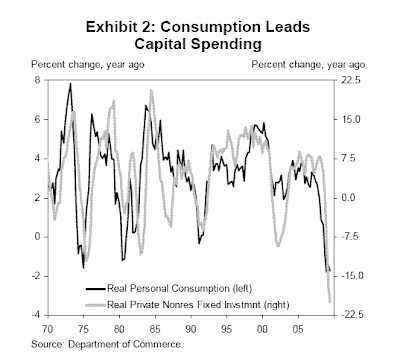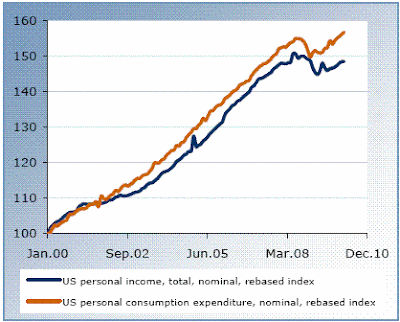Longer-term, I maintain this is not the “new normal,” but rather the typical economic cycle. That is, corporate profits surge, which drives an inventory rebuild. Currently, profits have indeed surged with the largest ramp in corporate cash (y/y) since 1983. Combined with the increased activity at seaports, and the rise in shipping prices, it suggests inventory restocking has begun. Following an inventory rebuild comes a capital expenditure cycle and then companies begin to hire people. Then, and only then, comes a noticeable increase in consumption. It is important to note that hiring and consumption come on the back end of the cycle, not the front end.
... capital spending represents "induced" demand. Few businesses will step up capital spending sharply unless they see a meaningful improvement in end demand for their products. Since the most important component of end demand for US companies is the domestic consumer, our cautious view of the outlook for personal consumption also implies a cautious view of capital spending, other things being equal. In essence, capital spending is the caboose of recovery, not the locomotive.
 Well, it looks like GaveKal is misleading to another "Our Brave New World"? And Goldman's guys failed to estimate the US consumption recovery? Assuming the fact, that personal consumption is supported by lifeline provided by government, this comes as a puzzle for corporates to step up capital expenditures and job creation? It seems that America has got a problem? Government taking on the liabilities of a sub-prime nation?
Well, it looks like GaveKal is misleading to another "Our Brave New World"? And Goldman's guys failed to estimate the US consumption recovery? Assuming the fact, that personal consumption is supported by lifeline provided by government, this comes as a puzzle for corporates to step up capital expenditures and job creation? It seems that America has got a problem? Government taking on the liabilities of a sub-prime nation?There was an even more interesting proposition by the economists at DBS last week, as much it can be regarded as irrational for corporate sector:
How much profits grow by depends on two things: how fast the economy grows and how that pie gets split up. The latter is by far the more important in the short- and medium term. Consider a couple of numerical examples below:
In the first scenario, assume that nominal GDP / national income grows at a 5%annualized rate through the four quarters of 2010. That’s a relatively fast clip (that could be achieved by, say, 4% real growth and 1% inflation). So it creates favorable conditions for continued profit growth. Second, assume that GDP growth leads to job growth and that the labor share of income returns to 51.5% by the end of 2010. That’s a relatively modest clawback for labor – the labor share would recoup about one-half what it lost in the previous year. Under reasonable assumptions, this scenario is consistent with payrolls growth of about 350k per month (on average) over the course of 2010. While that may sound high, it is only 62% of the monthly pace at which payrolls fell between Sep08 and Sep09 (when losses averaged 560k per month). As for the other components of national income – Mom & Pop shops, interest income, rental income and so on – assume their shares remain steady so as not to distort what happens as between wages and profits.

The results for such an experiment are shown in the chart above. A modest rise in the wage share, even along side a 5% growth rate in national income / GDP leaves profits languishing. Indeed, they drift southward over the course of 2010 from peak levels at 4Q09...
Raise the GDP growth rate to 8%? That helps, but not a lot. Profits still drop by about 1% per quarter if the wage share rises to 51.5%. Be more conservative on the wage share?Okay, put it at 51% by end-10 compared to 50.2% today. But with a 5% growth rate, that still implies profits falling by about 0.5% per quarter in 2010. The bottom line is that while in the long-run profits and wages go hand in hand, in the short-run one comes at the expense of the other.

No comments:
Post a Comment